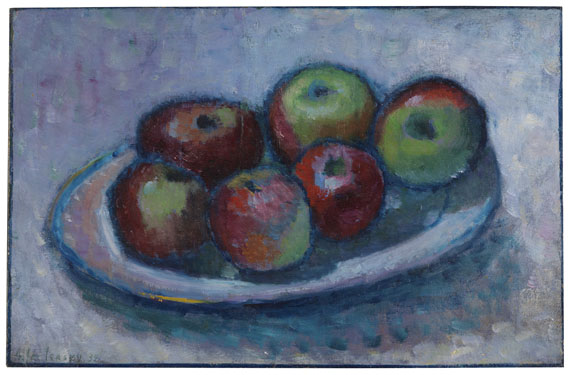215
Alexej von Jawlensky
Teller mit Äpfeln (Äpfelstillleben), 1932.
Oil on cardboard
Estimate:
€ 140,000 / $ 162,400 Sold:
€ 175,000 / $ 203,000 (incl. surcharge)
Teller mit Äpfeln (Äpfelstillleben). 1932.
Oil on cardboard, laid on board.
Jawlensky/ Pieroni-Jawlensky 2257. Jawlensky Bianconi supplement volume 3 CR (2257r). Signed and dated lower left. 26.2 x 40 cm (10.3 x 15.7 in).
Charming still life in appealing colors.
We are grateful to Angelica Jawlensky-Bianconi, Alexej von Jawlensky-Archive S.A., Locarno, for her kind support in cataloging this lot.
PROVENANCE: Collection Dr. Bernward Talleur, Hofheim im Taunus (since 1938/39, acquired directly from artist through the agent Hanna Bekker vom Rath).
Private collection, Hofheim im Taunus (inherited in 1965).
Private collection Germany.
LITERATURE: Angelica Jawlensky Bianconi, Zur Spaltung der Kartonbildträger Alexej von Jawlenskys, in: Alexej von Jawlensky-Archiv AG, Locarno (editor), Forschungsbeiträge zu Leben und Werk Alexej von Jawlenskys (Reihe Bild und Wissenschaft vol. 3), Locarno 2009, p. 147.
Nathalie Bäschlin, Alexej Jawlenskys Grüner Reiter – ein Kommentar aus restaurierungsethischer Sicht, in: Alexej von Jawlensky-Archiv AG, Locarno (editor), Forschungsbeiträge zu Leben und Werk Alexej von Jawlenskys (Reihe Bild und Wissenschaft vol. 3), Locarno 2009, p. 163.
Oil on cardboard, laid on board.
Jawlensky/ Pieroni-Jawlensky 2257. Jawlensky Bianconi supplement volume 3 CR (2257r). Signed and dated lower left. 26.2 x 40 cm (10.3 x 15.7 in).
Charming still life in appealing colors.
We are grateful to Angelica Jawlensky-Bianconi, Alexej von Jawlensky-Archive S.A., Locarno, for her kind support in cataloging this lot.
PROVENANCE: Collection Dr. Bernward Talleur, Hofheim im Taunus (since 1938/39, acquired directly from artist through the agent Hanna Bekker vom Rath).
Private collection, Hofheim im Taunus (inherited in 1965).
Private collection Germany.
LITERATURE: Angelica Jawlensky Bianconi, Zur Spaltung der Kartonbildträger Alexej von Jawlenskys, in: Alexej von Jawlensky-Archiv AG, Locarno (editor), Forschungsbeiträge zu Leben und Werk Alexej von Jawlenskys (Reihe Bild und Wissenschaft vol. 3), Locarno 2009, p. 147.
Nathalie Bäschlin, Alexej Jawlenskys Grüner Reiter – ein Kommentar aus restaurierungsethischer Sicht, in: Alexej von Jawlensky-Archiv AG, Locarno (editor), Forschungsbeiträge zu Leben und Werk Alexej von Jawlenskys (Reihe Bild und Wissenschaft vol. 3), Locarno 2009, p. 163.
The fruit still life, earlier just part of larger arrangements, had its first heyday in 17 th century Dutch still life painting. The joy in an artistic account of a mixture of domestic and exotic fruits is shown by the partly peeled lemons in these still lives, which add an optical zestto these works. Since Paul Cézanne adopted the apple still life into the canon of his works in the late 19 th century in order to find an artistic challenge in the motif's simplicity, it has been meandering with incessant admiration in works from modern classic to contemporary art. In 1900 the Kunstsalon Bruno and Paul Cassirer in Berlin showed works by Cézanne, among them several apple still lives, for the first time. Even though contemporary art critics did not find much praise for them they left impressive resonance on future generations of painters. Both the German late impressionists, especially Carl Schuch, who made remarkable works with this motif, as well as the expressionists discovered the apple still life for their art. Overshadowed by a long illness, Jawlensky approached the theme that he had already examined in strong colors in 1904 under the influence of late Impressionism, especially the art of van Gogh, once again in the last years of his life. All absorbed by his pictorial "Meditations", Jawlensky's recourse to earlier creations seems like a reminiscence of happier days.
215
Alexej von Jawlensky
Teller mit Äpfeln (Äpfelstillleben), 1932.
Oil on cardboard
Estimate:
€ 140,000 / $ 162,400 Sold:
€ 175,000 / $ 203,000 (incl. surcharge)
Headquarters
Joseph-Wild-Str. 18
81829 Munich
Phone: +49 89 55 244-0
Fax: +49 89 55 244-177
info@kettererkunst.de
Louisa von Saucken / Undine Schleifer
Holstenwall 5
20355 Hamburg
Phone: +49 40 37 49 61-0
Fax: +49 40 37 49 61-66
infohamburg@kettererkunst.de
Dr. Simone Wiechers / Nane Schlage
Fasanenstr. 70
10719 Berlin
Phone: +49 30 88 67 53-63
Fax: +49 30 88 67 56-43
infoberlin@kettererkunst.de
Cordula Lichtenberg
Gertrudenstraße 24-28
50667 Cologne
Phone: +49 221 510 908-15
infokoeln@kettererkunst.de
Hessen
Rhineland-Palatinate
Miriam Heß
Phone: +49 62 21 58 80-038
Fax: +49 62 21 58 80-595
infoheidelberg@kettererkunst.de
We will inform you in time.




 Lot 215
Lot 215 
